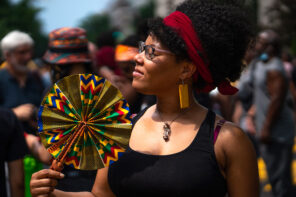I have a children’s book, by a black author, with black characters, drawn in almost string puppet formations, using primary colors throughout. The title is Made by God, So I must be Special. I love that book and now I pass it on to the next generation, my grandchildren. It is part of the Nana collection. The title says it all. With its sacred reminder, “by God,” it is obviously meant to affirm each and every child. In a world of phobias, prejudices, and discriminations, surely we need such reminders for our children.
But then, they become teenagers and maybe there is too much ego. What to do? I could just say, “You are not the center of the universe, you know?” But then, that would counter all those years of affirmation. So I temper it with the communal interdependent message: “You are not the only center of the universe.” As much as you think you are important, so likewise are others important.
And so it is with sacred places.
Each in some way is the ultimate focal point. But then with so many, how does one decide between them? I don’t even think we need to decide. I like the idea that one place is not the only sacred place; the more the merrier, really. I’ve been to my share of sacred places. If I get the chance, I choose to visit a sacred place before I visit a political place, or a financial one (and I never choose the commercial ones!). I had an 8-hour layover in Tokyo, and chose to visit a Buddhist temple over the Royal Palace. I had a 10-hour layover in Rome (the first of 7 or 8 visits to Italy) and I took the train in to see the Sistine Chapel. Cathedrals across Europe, temples across Asia, synagogues, natural formations used for worship the world over, and of course, mosques, mosques, mosques.
But what makes a place sacred? I like the interpretation of the word sacred as “set apart.” There is the everyday ordinary, and then, there is the non-ordinary: that which we set apart, or that sets us apart. Ever go into a huge sanctuary and yet still find yourself hushed to a whisper?
There is something about the awe that the place itself inspires. At some time, something occurred in these places that sets them apart from other places. The Church of the Holy Sepulcher in Jesusalem is where the body of Christ was laid to rest after crucifixion (and from where he was said to be resurrected). I stayed in a hostel just across from it so I could go there every day.
It was in Jerusalem that I got my best satiation for sacred places, because there are so many from Judaism, Christianity, and Islam all in one place; set apart from the rest of Israel by the prohibition of motor vehicles. I entered the dome of the rock and Masjid al-Aqsa through a darkened stairwell. I climbed over a hundred steps before I came up to the light of day, and then, there it was the golden splendor of the dome. Both the passage way in the dark and the movement up builds upon the perception and experience of entering a sacred place.
On the same location is the Majid al-Aqsa, the third most holy sight in Islam. From there I looked over and saw the Wailing Wall with Jewish worshipers (all male at that time) standing and bowing in prayer. I left the ancient city only twice in my Thanksgiving day weekend visit, once to mail T-shirts to my children at the local post office and once to see the sunrise over that golden dome. And where did I do that but from the Mount of Olives.
I was reminded it is not just the building we erect, in all their splendor, in celebration of the sacred event or person (because Jesus was laid to rest on a rock not in a church) but that we recognize them. Then we commemorate with awe and wonder, making that place a marker for that event or person. Our commemoration embodies our celebration of the set apart nature and bring us back to it, and thereby to the Divine.
Certain places in the world have an extraordinary flavor of this sacred commemoration without the building huge edifices: the island of Bali in Indonesia, for one; and Katmandu in Nepal, for two. In both those places, I just felt like everywhere everyone remembers the sacred. From bells to ring as you walk past them in Katmandu; to little daily offerings in the fronts of every store and office, as well as at the temples in Bali. These are reminders. We are reminded to reflect on that which is beyond the everyday ordinary. This kind of dhikr, or remembrance, helps us to celebrate that which we deem sacred. We participate in sacredness space and then we commemorate in our hearts.
So likewise the Kaaba, a cube-shaped building in the city of Makkah. It owes it original construction to two interesting phenomenon: 1) to the Prophet Abraham and his son Isma’il: as the place of worship to only one God. And 2) the site of an ancient meteorite, now called the black stone. This natural occurrence was itself sacred and then enhanced by years of continual reverence. It used to be the corner stone of the actual structure which was destroyed several times due to the unusual but occasional torrential rains in the desert. The pre-Islamic Arabs maintained the Kaaba as a sacred place even as they introduced into it their idols of worship. With the success of Islam in the peninsula, the idols were removed and the place once again designated to Allah, as one.
When it was established as the direction of prayer for Muslims a second phase in the marking of this place began. Think about it, for more than 14 centuries, the sincere (and not so sincere, I supposed) have turned their faces in the direction of this one place. Five times a day, remembrance of Allah, as one and true, is performed while turning towards this cube-shaped building.
With the changes across the world of various time zones, imagine: at some time, all the time, for over a thousand years, someone is turning toward this place in worship. I suspect the energy that has been amassed will be palpable. And so all who have entered it tell of being over come with emotion. In addition, for all of our lives we direct ourselves there in prayer and devotion. We even make prayer carpets that depict this building (among other designs). So it is a psychological home of our worship as well.
My female friends complain when they are pushed back from trying to approach too close, only because they are women. But with 2.5 to 3 million people all having the same desire; well, I won’t make it a pre-condition.
On the other hand, I do hope I can stand still, at least for a moment: maybe before or after the ritual prayers, and just “be” present with all that sacred energy and devotion. It may not be the only center of the universe, but I expect it will be the only one on my mind when I am close to it.




